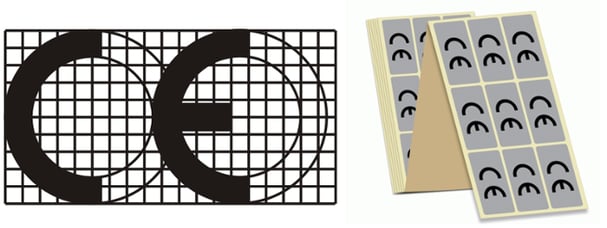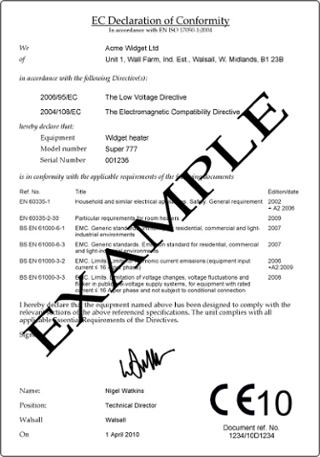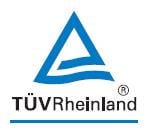“CE Marking” is required by law for products sold in European Union countries, but not accepted by OSHA and Inspectors in the US and Canada. The most obvious way to recognize a CE marked electrical product is to see the symbol on or near the nameplate. This symbol is not subject to copyright, and can be used by anyone.

If the product is marked, the CE Declaration of Conformity (DOC) must be available. The DOC is usually a one page document, describing the product and the Standards used for evaluation. Many times these are for EMC (Electromagnetic Compatibility) only, and don’t reference electrical safety Standards. Electrical products such as laboratory equipment would reference EN61010-1 as the safety Standard used for the Test Report, contained in the CE Technical Construction File. The Declaration is required to be signed by a legally authorized employee of the manufacturer, and this person becomes liable under EU law if there is an incident or casualties. This document is sometimes shipped with the product, or is in the manual. But what happens when this document is a lie?
Maybe it’s from a reputable organization, but how would you know?
The Declaration of Conformity is an implied guarantee that there is a Technical Construction File, containing Test Reports, details on components used, and other information. The Test Report can be helpful in the course of a Field Evaluation project, but there are still many questions: Was it performed by a recognized testing laboratory or competent product safety engineers? Is the product still the same as when it was evaluated and tested?

During the course of a Field Evaluation project, we often ask for the test report, but we find out it cannot be produced. Was evaluation and testing even performed? Why would a manufacturer falsify legally binding documents? Does the person signing the Declaration even know what they are signing? Do they know what the required file is supposed to contain? If they do, would they sign it?

Why take the chance? Why would anyone lie about this?
Few Requests by EU Authorities for the Actual Test Report. In most cases, buyers in the European Union and port authorities only look at the surface and accept the CE Mark at face value. The Declaration of Conformity might be examined, but do they know how to interpret the information on this document? Perhaps there is an attitude that the manufacturer is claiming legal responsibility so no further questions need to be asked.
Lack of Expert Regulatory Staff or Training. Many manufacturers don’t design their own products, so in many cases the designer is just providing them what they ask for: A product that performs a needed function. Other manufacturers have product designers, but they have no knowledge of product safety Standards, and safety features are an afterthought.
Lack of Test Equipment and Testing Facilities. Most manufacturers do not have the product safety testing laboratory and equipment needed to verify compliance with the applicable Standards. Many product Standards require Dielectric testing, environmental conditioning, flammability testing, Leakage current testing, just to name a few. If there even is a Test Report, were all the tests actually performed?
Rush to Market - No Regulatory Budget. Product developers, venture firms, financial analysts create budgets and milestones for design, prototyping and manufacturing, but many times product regulatory is missed. Then after the product is already completed, someone realizes that National or International Standards have to be met. At that point it may be too late, and delays or redesign are not allowed. At this late stage, perhaps they can’t take a chance on testing laboratory failures and missed deadlines.
These falsely “CE Marked” products are coming from all over the world, including Western Europe, where there is a long history of designing to Product Safety Standards. Why? Because without market surveillance, some manufacturers will cut corners. This makes it difficult for the many responsible manufacturers who actually know how to design and produce a safe product.
CE Marking is not valid in North America, but many electrical inspectors, equipment buyers and hospitals are asked to accept the CE Mark as evidence of Safety Certification. Don’t be fooled – this is not Product Certification. When a responsible manufacturer certifies products, the testing laboratory conducts periodic unannounced inspections. Sometimes the right to apply the legal NRTL Mark is suspended or withdrawn. In some cases, products are recalled. In the US, OSHA and Electrical Inspectors rely on Nationally Recognized Testing Laboratories like TUV Rheinland to assure that the correct evaluation and testing is actually performed.
With CE Marking, the legal authority is the European Union. If a CE Marked product is suspected of not meeting the requirements in the EU, or if there is an incident, this can mean potential fines, products being quarantined, blacklisting or even imprisonment.
How to avoid these problems?
Product designers and manufacturers need to start the product regulatory process early. Sometimes this means hiring a product safety engineer with experience, but it should always involve experts in product evaluation and testing. With the right planning and preparation, the product safety approval process can be predictable and reduce legal liability. All the incomplete and false documents are unnecessary and unacceptable. They hurt honest competition and place our families and friends in mortal danger. Innovation is so very important, let’s make sure that industry isn’t crippled by irresponsible manufacturers. Product Safety professionals are ready to help.
Contact us today if you have any additional questions about CE Marking or visit our website for more information



